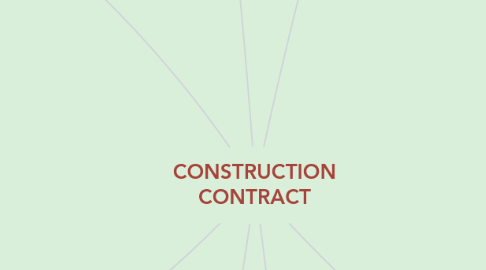
1. DEFINITION
1.1. contract between 'employer' and 'contractor'
1.2. purpose
1.2.1. for the employer to get contractor's services for the construction project in consideration for the employer's payment of contract's sum
2. CONTRACT PARTIES
2.1. employer and contractor
2.2. other parties
2.2.1. employer and consultant
2.2.2. main con and subcon
2.2.3. MC / SC and supplier
2.2.4. MC / SC and labour only subcon
3. EXPRESS DUTIES
3.1. Employers
3.1.1. clause 38 : duty to give possession of site
3.1.2. clause 47 : duty to pay
3.2. Contractors
3.2.1. clause 4 : contractor's duty in general
3.2.2. clause 5 : duty to comply with SO instructions
3.2.3. clause 15 : site inspection / condition
3.2.4. contractor's duty is to supply goods and materials
3.2.4.1. Transfer of title in materials and goods supplied
3.2.4.2. Liability for quality of goods and materials
3.2.4.3. Liability for workmanship
3.3. employer implied duty
3.3.1. main implied duties
3.3.1.1. duty to corporate
3.3.1.2. duty of non-hindrance
3.3.1.2.1. to prevent the contractor from earning profit
3.3.2. appoint consultants
3.3.3. provide contract documents
3.3.4. get the necessary approvals
3.3.5. nominate subcontractors/suppliers
3.4. contractor implied duty
3.4.1. warn defective designs/drawings
4. DISTRIBUTES RISKS
4.1. Levels & setting out
4.2. Site conditions
4.3. Public safety
4.4. Safety of works
4.5. Safety/quality of materials and goods
4.6. Date of completion
4.7. Insolvency
4.8. RISKS MANAGEMENT TOOLS
4.8.1. Express transfer of risk
4.8.2. Insurance
4.8.3. Subcontracting
4.8.4. Termination
5. SETS OUT CONDITION
5.1. Giving possession of site
5.2. Payment
5.3. Final Account
5.4. Partial Possession
5.5. Assignment/Subletting
5.6. Variation order
5.7. Liquidated & ascertained damages (LAD)
5.8. Payment
5.9. Instructions to contractor
5.10. Loss and expense
5.11. Termination of contract
5.12. Dispute resolution
6. PROCUREMENT METHODS
6.1. TYPES OF PROCUREMENT METHOD
6.1.1. Traditional/conventional
6.1.2. Design & Build
6.1.3. Construction Management
6.1.4. Management Contracting
6.1.5. Build-Operate-Transfer
6.1.6. Partnering
6.2. CHARACTERISTICS OF CHOOSING THE BEST METHOD
6.2.1. Employers requirements.
6.2.2. Distribution of risk.
6.2.3. Complexity of design and construction.
6.2.4. Development in construction management and technology.
6.3. STANDARD FORMS (BORANG)
6.3.1. The contract terms are determined by:
6.3.1.1. employers
6.3.1.2. Contractor & Employer
6.3.1.3. Custom designed by professional for a particular project
6.3.1.4. Statutes (ketepatan)
6.3.1.5. Standard forms (yang sedia ada/biasa digunakan)
6.3.2. ADVANTAGES
6.3.2.1. Safe money, time, effort
6.3.2.2. Familiarity facilitate management & control
6.3.2.3. Certainty - terms have been judicially interpreted
6.3.2.4. Continuous revisions and amendments taking into account judicial pronouncements and changes in statutory rules
6.3.3. TRADITIONAL PROCUREMENT METHOD
6.3.3.1. UK
6.3.3.1.1. JCT
6.3.3.1.2. ICE
6.3.3.2. MSIA
6.3.3.2.1. JKR
6.3.3.2.2. PAM
6.3.3.2.3. CIDB
6.3.3.3. INTERNATIONAL
6.3.3.3.1. FIDIC
7. CONTRACT DOCUMENT
7.1. ARTICLES OF AGREEMENT
7.1.1. Clauses or rules in a document
7.1.2. Record in general terms matters that the parties have agreed to do
7.2. CONDITIONS OF CONTRACT
7.2.1. Detailed clauses that follow on the Articles of Agreement
7.2.2. PURPOSES :
7.2.2.1. to amplify and explain further the duties of the parties.
7.2.2.2. To set out the conditions and procedures
7.2.2.2.1. Example: Extension of Time
7.2.2.3. To provide the administrative mechanism
7.2.2.3.1. Examples: Architect’s instructions, Certificates
7.2.3. SPECIFICATIONS
7.2.3.1. A document that defines materials and goods to be used, the standard of workmanship, method of working and the conditions for execution of their execution.
7.2.3.2. Determine the method of construction, quality of finishes and workmanship.
7.2.4. BQ
7.2.4.1. define the whole of the contractor’s obligations for quality and quantity of work
7.2.4.2. basis for the contractor’s estimates of the tender price
7.2.5. DRAWINGS
7.2.5.1. TYPES
7.2.5.1.1. architectural,
7.2.5.1.2. isometric,
7.2.5.1.3. scheme design
7.2.5.1.4. engineering
7.2.5.1.5. working or detailed drawings
7.2.5.2. They are prepared in stages as the construction progresses for various purposes:
7.2.5.2.1. Presentation of the designer’s idea & creativity
7.2.5.2.2. extracting information regarding materials, methods of working
7.2.5.2.3. Set out the contractor’s scope of work
7.3. SUBCONTRACTING
7.3.1. TYPES OF SUB-CON
7.3.1.1. NSC / NS
7.3.1.2. DSC / DS
7.3.1.3. LABOUR ONLY SUBCON
7.3.2. ADVANTAGE
7.3.2.1. non-wage cost of employment
7.3.2.1.1. training
7.3.2.1.2. pension
7.3.2.1.3. medical
7.3.2.1.4. redundancy
7.3.2.2. increase need in diverse skills in modern & complex projects
7.3.2.3. rising expectation of workers and increase shift to free lancing
7.3.2.4. transfer of risk
7.3.2.5. employer’s wish to let works carried out by specialist subcontractors of own choice

